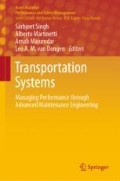Abstract
Condition-based maintenance (CBM) strategies have increased in recognition over the last decades, and continues to do so with an internationalized market and cheaper sensor technology. CBM is in many cases the most effective approach to maintenance, considering risk, resource use, sustainability, safety and cost. Thus, CBM is often feasible both from a life-cycle cost (LCC) perspective and a life cycle analysis (LCA) perspective. In this chapter, we will study risk-based and condition-based maintenance from a maintenance and reliability perspective. After a brief background, we will discuss the necessary conditions for CBM to be a feasible strategy for optimized usage of equipment. On the operational level, CBM can be on schedule, on request or on a continuous monitoring basis. Thus, the technologies used for CBM can broadly be divided into continuous monitoring, which often is simply called condition monitoring, and into non-destructive testing (NDT), for periodic inspections. Therefore, two sections are dedicated to condition monitoring and NDT. Additional techniques for CBM and risk assessment will be discussed in the section thereafter. Lastly, we will look briefly into the continuously growing topic of prognostics.
Access this chapter
Tax calculation will be finalised at checkout
Purchases are for personal use only
Notes
- 1.
A methodical, disciplined approach for the design, realization, technical management, operations and retirement of a system (NASA 2007).
- 2.
The point in time when the deterioration is detectable.
References
AAIC. (1987). Aircraft accident investigation report.
Al-Chalabi, H., Lundberg, J., Ahmadi, A., et al. (2015). Case study: Model for economic lifetime of drilling machines in the Swedish mining industry. The Engineering Economist, 60(2), 138–154. https://doi.org/10.1080/0013791X.2014.952466.
ASCE. (2011). Failure to act: The economic impact of current investment trends in surface transportation infrastructure.
Ben-Daya, M., Kumar, U., & Murthy, D. N. P. (2016). Introduction to maintenance engineering: Modelling, optimization and management.
CEN. (2010). EN 13306: Maintenance terminology.
Drenick, R. F. (1960). The failure law of complex equipment. Journal of the Society for Industrial and Applied Mathematics, 8(4), 680–690.
Frangopol, D. M. (2011). Life-cycle performance, management, and optimisation of structural systems under uncertainty: Accomplishments and challenges. Structure and Infrastructure Engineering, 7(6), 389–413. https://doi.org/10.1080/15732471003594427.
Goebel, K., Saha, B., Saxena, A., et al. (2008). Prognostics in battery health management. IEEE Instrumentation and Measurement Magazine, 11(4), 33–40. https://doi.org/10.1109/MIM.2008.4579269.
IEC. (2015). IEC 60050-192:2015: International electrotechnical vocabulary—Part 192: Dependability.
ISO. (2009). ISO 31000:2009: Risk management—Principles and guidelines.
ISO/IEC. (2009). ISO/IEC 31010: Risk management: Risk assessment techniques.
Kececioglu, D. (1991). Reliability engineering handbook (Vol. 2).
Lei, Y., Li, N., Guo, L., et al. (2018). Machinery health prognostics: A systematic review from data acquisition to RUL prediction. Mechanical Systems and Signal Processing, 104, 799–834. https://doi.org/10.1016/j.ymssp.2017.11.016.
McInerney, P. (2005). Special commission of inquiry into the waterfall rail accident (Final Report).
Mishra, M., Odelius, J., Thaduri, A., et al. (2017). Particle filter-based prognostic approach for railway track geometry. Mechanical Systems and Signal Processing, 96, 226–238. https://doi.org/10.1016/j.ymssp.2017.04.010.
Murphy, K. E., Carter, C. M., & Brown, S. O. (2002). The exponential distribution: The good, the bad and the ugly. A practical guide to its implementation. In Proceedings of Annual Reliability and Maintainability Symposium (pp. 550–555). https://doi.org/10.1109/rams.2002.981701.
NASA. (2007). Systems engineering handbook.
Nectoux, P., Gouriveau, R., Medjaher, K., et al. (2012) PRONOSTIA: An experimental platform for bearings accelerated degradation tests. In IEEE International Conference on Prognostics and Health Management (pp. 1–8).
Nowlan, F. S., & Heap, H. F. (1978). Reliability-centered maintenance.
OECD. (2006). Infrastructure to 2030: Telecom, land transport, water and electricity. https://doi.org/10.1787/9789264043466-en.
ORR. (2006). Train derailment at Hatfield: A final report by the independent investigation board.
Randall, R. B., & Antoni, J. (2011). Rolling element bearing diagnostics—A tutorial. Mechanical Systems and Signal Processing, 25(2), 485–520. https://doi.org/10.1016/j.ymssp.2010.07.017.
Rausand, M., & Høyland, A. (2004). System reliability theory: Models, statistical methods, and applications.
Roe, G. J., & Bramfitt, B. L. (1990). Notch toughness of steels (pp. 737–754).
Stenström, C., Carlson, J. E., & Lundberg, J. (2015). Condition monitoring of cracks and wear in mining mills using water squirter ultrasonics. International Journal of Condition Monitoring, 5(1), 2–8.
Uckun, S., Goebel, K., & Lucas, P. J. F. (2008). Standardizing research methods for prognostics. In International Conference on Prognostics and Health Management, PHM. https://doi.org/10.1109/phm.2008.4711437.
Acknowledgements
The authors would like to thank Dr. Madhav Mishra, Luleå University of Technology, for his valuable comments that improved this chapter.
Author information
Authors and Affiliations
Corresponding author
Editor information
Editors and Affiliations
Rights and permissions
Copyright information
© 2019 Springer Nature Singapore Pte Ltd.
About this chapter
Cite this chapter
Stenström, C., Singh, S. (2019). Risk- and Condition-Based Maintenance. In: Singh, S., Martinetti, A., Majumdar, A., Dongen, L. (eds) Transportation Systems. Asset Analytics. Springer, Singapore. https://doi.org/10.1007/978-981-32-9323-6_5
Download citation
DOI: https://doi.org/10.1007/978-981-32-9323-6_5
Published:
Publisher Name: Springer, Singapore
Print ISBN: 978-981-32-9322-9
Online ISBN: 978-981-32-9323-6
eBook Packages: Business and ManagementBusiness and Management (R0)

